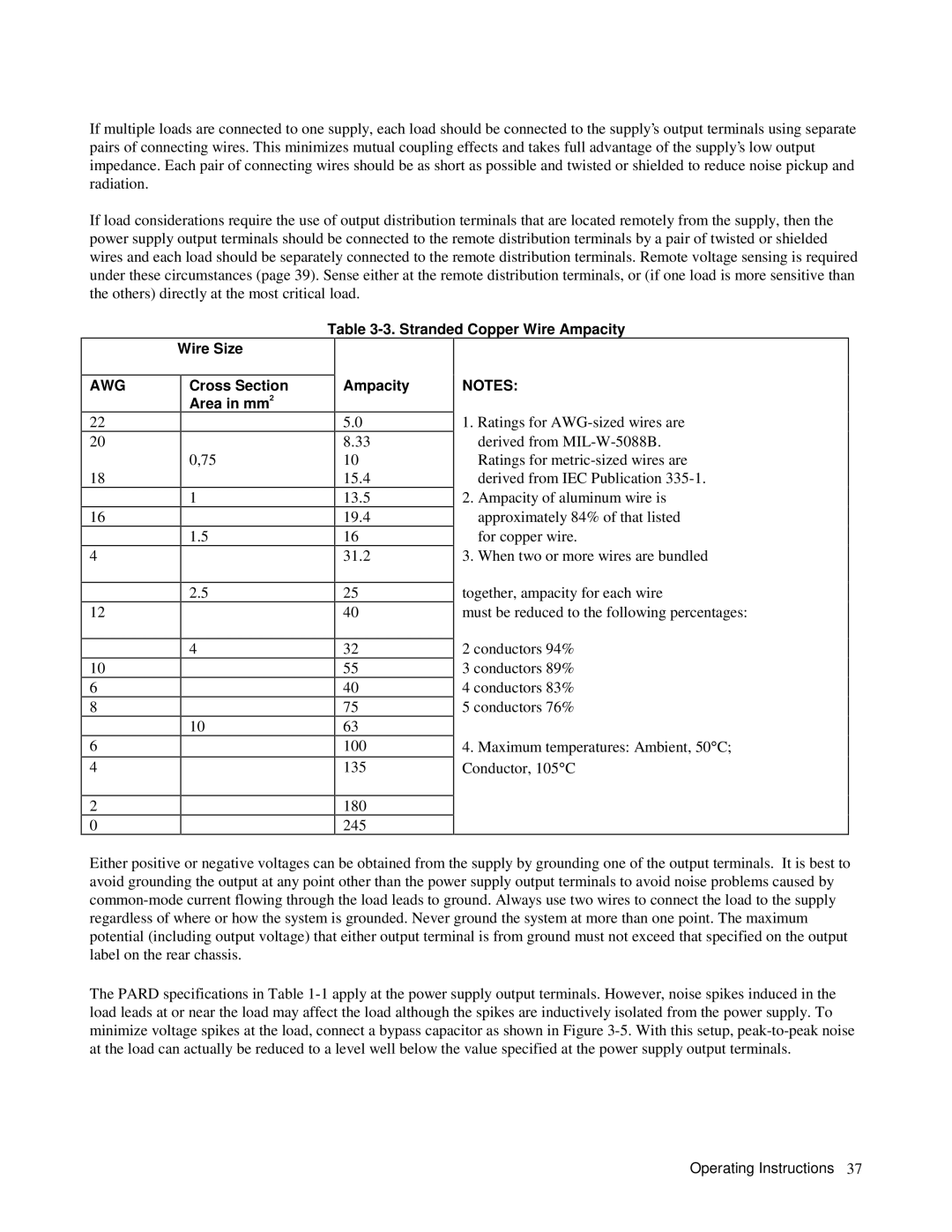Operating Manual
Certification
Do not Service or Adjust Alone
Before Applying Power
General
Environmental Conditions
Safety Symbols
EMC
Declaration
Manufacturer’s Declaration
Herstellerbescheinigung
Table Of Contents
Table Of Contents
Standard Commands for Programmable Instruments
VAC Input Power Option
Blank Front Panel Option
Index
Description
Introduction
Accessories
Safety Considerations
Options
Instrument and Manual Identification
GP-IB Compatibility
GP-IB Interconnection Cables and Connectors
Ordering Additional Manuals
Model
Related Documents
Specifications
Ieee
6038A
Performance Specifications Agilent Technologies Model 6033A
6031A
6030A
6032A
6035A
Supplemental Characteristics
6035A 6038A
Agilent Model
General Information
Preparation For Use
Initial Inspection
Power Connection
Input Power Requirements
Rack Mounting
Power-Cord Plug Configurations
Line Voltage Option Conversion
Installation
Line Voltage Conversion Components
Repackaging For Shipment
AC Line Impedance Check
Rear Panel Screw Sizes and Part Numbers
Agilent Models 6030A, 6031A, 6032A, 6035A
Agilent Model 6038A
Agilent Model 6033A
Operating Instructions
Output Range For An Autoranging Power Supply
Controls and Indicators
Overrange Operation Controls and Indicators Description
Number Controls/Indicators
Operating Instructions
OVP Adjust
Turn-On Checkout Procedure
Factory Settings, Mode Switch
Connecting the Load
Initial Setup and Interconnections
AWG
Maximum Wire Lengths To Limit Voltage Drops
Cross Section Area Mm2 Kft 10A 17 a
Cross Section Area in mm2 Ampacity
Stranded Copper Wire Ampacity Wire Size
Connecting a Bypass Capacitor Overvoltage Protection OVP
Foldback Protection
Remote Voltage Sensing
Remote Voltage Sensing
Mode Switches
Mode Switches Programming Mode
Mode Switches
GP-IB/RPG
Voltage Resistance
Protective Circuits
Monitor Signals
Constant Voltage Operation
Local Operation
Constant Current Operation
GP-IB Operation
Return to Local
Interface Functions
Operating Instructions
RQS
GP-IB Address Selection
Serial Poll Register
ERR RDY PON FAU
INH-FLT or RLY LNK Operation
Power-On Service Request
Initial Conditions
Programming Syntax
Output Adjust
OVP
Unmask CC or Fold
Unmask CC,OR,FOLD Unmask CC, OR, Fold
Vset 5 V VSET5V
VMAX? Vmax ?
VMAX? IMAX?
VSET? ISET? VOUT? IOUT? OVP?
GP-IB Commands Range or **Response To Query Description
Command
HOLD?
STS? ASTS?
TRG
UNMASK?
FAULT?
SRQ OFF SRQ SRQ on SRQ SRQ? CLR ERR?
SRQ OFF
Vout 15VIOUT 5A Vout 15V Iout 5A
TEST? ID?
STS? FAULT? ASTS? ERR? UNMASK? TEST?
Format of Numbers Sent from Power Supply
VSET? ISET? DLY? VOUT? IOUT? VMAX? IMAX?
FOLD? HOLD? OUT? SRQ?
Iset Iset 5 a Iset 5 MA
VSET?
OUT on RST
Vmax Imax Vmax 15 Imax 5 a Vmax 15 MV Imax 5 MA
DLY?
OUT ?
HOLD?
STO
Output PS1 Hold ON’’ 5A’’
STS?
Condition
Status Register Bit Position Bit Weight
Fold
ERR
Unmask CC, OR, ERR
Fault
Unmask
TEST?
No Errors
Error # 10. Status Register Errors Description
Analog Programming
Resistance Programming of Output Voltage
10. Voltage Programming of Output Voltage
Multiple-Supply Operation
12. Resistance Programming of Output Current
Series Operation
14. Auto-Parallel Operation
15. Series Operation
Fault Input FLT and Remote Inhibit INH Connections
16. FLT/INH Connections
19a. FLT and INH with Multiple Supplies
20. Timing Diagram
Page
General Information Description
Using Appendix a
Scope of Appendix a
Manual Changes
Section lll Manual Changes
Section ll Manual Changes
Page
Page
Introduction
Turn-On Check Out Procedure
Possible failure
Response
Table B-1. ID Query Response Agilent Model
Vset 20 Iset
STS
Overvoltage Protection Setting
Table B-2. CC Check Command String Agilent Model
String
Page
Standard Commands for Programmable Instruments Scpi
Introduction
Linked Connections
GP-IB
Subsystem Commands
Common Commands
Keywords
Parameters
Figure C-2. Common Command Syntax Diagram
Bit Configuration of Standard Event Status Enable Register
Command Syntax
Meaning and Type
PON CME EXE DDE QYE
ESR? *PSC *STB?
ESE?
ESR?
OPC?
Pending operations are complete when
Default Value Example PSC
Command Syntax PSC bool Parameters
PSC?
Returned Parameters NR1
RST
Command Syntax*SAV NRf Parameters Example
SRE?
Bit Configuration of Status Byte Register
Oper
1MSS ESB MAV Ques
TST?
TRG
WAI
Abor Abort
Currlev
Command Syntax SOURceCURRentPROTectionSTATe bool Parameters
Currprotstat
Curr Prot Stat 0 Current Protection State OFF
Initcont 1 Initiatecontinuous
Init Initiate Immediate
Meas CURR? Meas VOLT? Measure Voltage DC? MV
Outp 1 Output State ON, Norelay
Outpprot
Outpprotdelmin Outputprotdelay MAX
Outp Prot CLE Output Protection Clear
OUTPPROTDEL? MIN OUTPPROTDEL? MAX
Status Operation Registers
Bit Configuration of Operation Registers
STATOPEREVEN?
Bit Configuration of Questionable Registers
NTR/PTR Commands
Statpres
Status Questionable Registers
Statquesenab
STATQUESCOND?
STATQUESEVEN?
Statquesntr 16 Statusquestionableptr
Syst ERR? System ERROR?
STATQUESNTR? STATQUESPTR?
Systlang Tmsl Systemlanguage Compatibility
Trigsour
Volt PROT? Voltage Protection AMPLITUDE?
VOLTPROTAMPL?
Questionable Status Group
Status Byte and Service Request Enable Registers
Bit Signal
Questionable Status Group
Standard Event Status Group
Register
PTR NTR
Status Programming Examples
Service Request Enable Register
ESE
Status Byte Register
Device-Dependent Errors
Standard Event Status Register Error Bits
Output Queue
SRE
Error Number
Command Summary Subsystem Commands
Scpi Command Summary
Initimm Initcont INITCONT? MEASCURRDC?
Common Commands
Table C-6. Comparison of Arps and Scpi Commands
ARPS/SCPI Commands
Equivalent Scpi Command
Arps
Page
Initialization
Path Names
Voltage and Current Programming
Output @PS Vset
Output @PSVOUT? Enter @ PSA
Voltage and Current Readback
END While
Power Supply Status
Output Inhibit / Enable
Present Status
ERR Fold
Accumulated Status
Serial Poll
Fault and Mask Registers
Output @PSUNMASK CC, OR, OV,AC
SPOLLRESP= Spoll @PS
RQS ERR RDY PON FAU
Output @PSSRQ on Output @PS~SRQ OFF
Service Request
Programming Error Detection
Delay Time
Output @PS ERR? Enter @PSERRCODE
OFF KEY
Protection Functions
Fault Indicator FLT and Inhibit INH
Overvoltage
Foldback
Advanced Topics
Hold Mode
Machines States
Output @PSSTO 10RCL
210 ! Loop Through the States 10 Times
Page
Index
Atsl Ieee
GET
OC bit 98, 101
Tmsl
SH1 SR1
Europe Japan
United States Canada
Latin America Australia/New Zealand
Asia Pacific
Manual Updates

